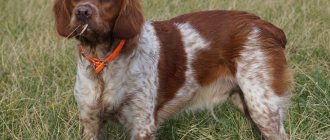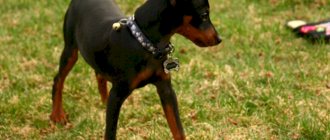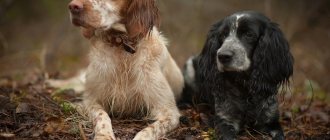| Origin: | France |
| Usage: | game hunting, pointing |
| Color: | white with orange, chestnut or black spots |
| Dimensions: | 47 – 51 cm, 14 – 18 kg |
| Lifespan: | 12 – 15 years |
The Breton Epagnole is an amazing dog. She combines the passion of a hunter and a companion at the same time. She is passionate in the field or forest and calm at home, merciless towards prey and affectionate with her family. Amazing working qualities, coupled with flexibility and the desire to please the owner, have won the love of thousands of dog lovers.
Origin story
Do you want to get a Breton Epagnole?
Yes
39.53%
While I'm thinking
41.86%
Has already!
18.6%
Epagnoles are often called Breton or French spaniels. The confusion stems from their similar appearance. But the only thing the breeds have in common is that both hunt birds. However, their methods are different. The Epagnole is a pointer, so when it detects game, it stops and takes a characteristic stance, and the spaniel picks up the birds.
There is also no single version about the meaning of the name of the breed. Everything is clear with the word Breton - it comes from the French province of Brittany, where national cops originated. But historians have different opinions about the term “epagnol”. Some believe that it indicates the kinship of the Bretons with Spanish bird dogs, others associate it with the Old French word “to lie down,” which describes the dog’s behavior on the hunt - when it smells prey, it first freezes, sits up straight, and then lies down.
The Breton Epagnole is a relatively young breed. It was recognized only at the beginning of the 20th century. Although mentions of dogs date back to the 17th century, images are found in the works of Dutch artists.
The first documentary description of the breed dates back to 1850. The clergyman Davis outlined the process of hunting a bird, where he mentioned dogs with a stubby tail and a wavy coat.
They began breeding and improving the breed in 1990. Just 7 years later, the Breton Spaniel was presented at an exhibition, where dog handler Arthur Enyud brought a male dog named Boy. It was then that a draft standard was developed. It was approved on June 7, 1908 under the auspices of the Breton Lovers Club.
In the CIS countries the breed is still developing. Only in 2010, the All-Russian Canine Council introduced a national stud book for the Breton Spaniol.
Standard requirements
The Fédération Cynologique Internationale (FCI) approved the modern breed standard in 2003. She classifies the Breton Epagnole as a group of cops.
The French Epagnole is a lively, active dog, the smallest of all continental pointers. She belongs to the breeding dogs - those that are born with a short tail or no tail at all. The animals are stocky, seem knocked down, but are not devoid of grace and lightness.
| Parameter | Description |
| Height | Males: 48-51 cm, ideally 49-50 cm. Females: 47-50 cm, ideally 48-49 cm. |
| Weight | Not limited to standard. Greater importance is given to the proportionality of addition. Approximately – 14-18 kg. |
| Frame | Square – the length of the body is equal to the height at the withers. The back is straight, not long, with a wide loin. The chest is voluminous - its depth reaches half the height of the Breton epagnole. The stomach is slightly tucked. |
| Head | In the form of a worn-out shoe, this is a distinctive feature of the breed. The head is dry and proportional to the body. The length of the skull and muzzle have a ratio of 3:2. |
| Ears | In the shape of a triangle, they stand high. Moderately wide and relatively short. The upper part is covered with long hair, the lower and side areas are covered with short fur. |
| Eyes | Oval, stand slightly slanted. The color is preferably dark, but warm shades are allowed in dogs with a light color. The edging of the eyelids matches the suit. |
| Nose | Wide with large nostrils, lobe color to match. |
| Wide with large nostrils, lobe color to match. | Moderately large, thin, the upper lip covers the lower lip in some areas. |
| Bite | Scissor-shaped. |
| Limbs | Limbs |
| Limbs | Round, in a lump. The hind ones are larger than the front ones. |
| Tail | Puppies with a small tail (up to 10 cm) or without one are allowed. Optimal length – 3-6 cm. Planted high. |
| Wool | Smooth or with a wave. Short on head, chest and front legs. On the back of the body it is longer, with feathering. |
| Color | Only two colors are allowed. The main background is white combined with orange, brown or black. Specks are allowed on the front legs, muzzle, chest, and at the base of the tail. Thin markings and a blaze on the forehead are desirable. |
The character of the Breton epagnol
The Breton Spaniel behaves almost the same as the Cocker Spaniel. He is playful, curious and active.
However, if the Cocker Spaniel loves everyone, then the heart of the Breton Spaniel belongs only to the owner. He singles him out especially - if you give an adult dog to another person, he will become sad and wither.
The Breton epagnole also loves the rest of the family. He rejoices at the return of everyone, protects and protects children.
With strangers, Epagnole Breton is reserved. He will allow himself to be petted, perhaps even play. But he only cuddles with people he knows well.
The pet’s devotion also affects its working qualities. No matter how passionate the Breton Spaniel is about the prey, he does not lose contact with the hunter - the dog remains in sight and obeys orders.
The downside of the Breton epagnol is the intolerance of loneliness. He needs constant contact with his owner, or, in extreme cases, with family members or pets. Left alone, the dog becomes sad and may howl or damage furniture and clothing.
If you believe the reviews of the owners, the Breton Spaniol has psychic abilities. He understands what the owner wants instantly. And if a person is looking for something, the dog guesses what is needed and brings the thing or points to it with a jerky bark.
The character of these dogs
Breton Epagnole is popular as a companion. This is a good-natured, cheerful and sociable dog. She is calm, flexible, and has a balanced character. Gets along with all family members and is friendly. He loves children, treats them carefully, without showing displeasure at any pranks. The dog is ready to run and play with them all day, to protect them.
Breton Spaniolas are not prone to dominance, therefore they are obedient and flexible. They get along well with any pets. Although on the street they may show hunting instincts towards other people's cats, birds and rodents. They do not express aggression towards strangers, are friendly, and allow themselves to be petted.
This dog adapts to any lifestyle of its owner. He becomes very attached to him and misses him greatly when he is apart. With prolonged loneliness, a dog can develop depression. With a lack of physical activity, she can howl and ruin things. Loves to accompany the owner everywhere and participate in all activities. This dog is energetic, playful, and resilient. This is a wonderful companion for traveling, cycling, hiking. But most of all it is adapted for hunting - these qualities are innate in it.
The Bretons have the following character traits:
- equilibrium;
- cheerfulness;
- good nature;
- sociability;
- intelligence;
- curiosity;
- devotion.
Education and training
These dogs are smart and easy to train. The owners note that they understand a person perfectly and try to please. Their hunting qualities are innate; training can begin at 5-7 months. The dog is trained to track prey, moving in a “shuttle” motion, to freeze in a stance, to find and bring game. So that the dog is not afraid of gunshots, it must be socialized from an early age: familiarize it with noise, loud sounds, and unfamiliar people.
If the dog will not be used for hunting, it is enough for him to learn the usual commands: “come to me”, “near”, “place”, “sit”, “stand”, “no”, “fetch”. Even an inexperienced dog breeder can do the training, the main thing is to follow a few recommendations:
- start training from the first days the puppy appears in the house, all family members must adhere to the same requirements;
- be persistent, but not rude, avoid raising your voice and physical punishment;
- be patient, consistent, classes should be regular;
- For success, be sure to praise and reward the puppy with treats.
Application
Today, the French Epagnole is bred as a companion dog. He gets along with any family and adapts to people's lifestyles.
However, the purpose of the Breton epagnol is hunting game birds. It is used to track partridges, pheasants, woodcocks, and quails, although the pet handles all birds equally well. The dog is tireless and can work all day. It is equally good in the field, forest and on ponds.
In the heat, the dog is allowed to rest and cool down every hour - otherwise he will develop heatstroke or sunstroke.
The Breton Spaniel has an excellent sense of smell. He can smell a bird 70 -100 meters away.
If the French Cocker Spaniel takes birds on its wing, then the Breton Spaniel is a hunter of a different order. He combs the field with a shuttle at a distance of 50-100 m in each direction. And when it senses prey, it freezes in a stance and patiently waits for its owner. Only when he approaches does the dog carefully approach the bird. Moreover, a quail or a pheasant is often scared away by a person so as not to expose the pet to a gun.
Some Breton epagnols master the highest art of cops - an announcement or a report. When the dog smells game, it carefully leaves the stand, looks for the owner and leads him to the bird left for a while.
Advantages and disadvantages
It is quite difficult to find negative qualities in Breton epagnoles - there are much more positive aspects.
pros
- Sociability and friendliness.
- Devotion.
- There is no aggression or desire to dominate.
- Intelligence and learning ability.
- Excellent attitude towards children.
- There are no conflicts with other pets.
Minuses
- Cannot be used as a guard or guard dog.
- The need for socialization and proper education.
- Demanding to be active and satisfy the hunting instinct.
- Education and training.
Socialization and education
The French spaniel is a pet for active, sporty people. A kind and affectionate Breton will get along with any person and animal.
The dog loves children, allows kids to pull on his ears and fur, and is ready to run and frolic with the kids for hours. At the same time, the Breton epagnol is careful and will not even accidentally push the child.
Breton Spaniards get along well with other pets. They don't tend to dominate. They get along well with relatives, cats and rodents. Problems arise only with birds. However, with proper upbringing and socialization, the Breton learns that this animal is dear to the owner and should not be touched.
The Epagnole Breton is easy to train. He will jump out of his skin, but he will please his owner. Therefore, the dog is suitable for beginners.
The rules of behavior for the Breton Spaniard are explained up to six months. From 7 months they begin the general course of training (OCD). And after mastering the program, they teach hunting.
It is easy to train a Breton Spaniel to hunt game. Tracking prey and taking a stance is in the blood of hunting breeds. Some dogs make their first attempts to hunt at 4-5 months.
Breed traits
Breed traits (on a 5-point scale)
| Breton epañol | |||
| Activity | in the house | 3.2 | |
| on the street | 4.6 | ||
| Obedience | training | 3.9 | |
| strangers | 3.9 | ||
| Domination | in family | 1.6 | |
| over dogs | 2.2 | ||
| Defending your territory | from people | 1.7 | |
| from dogs | 2.2 | ||
| Sociability | in family | 4.8 | |
| with strangers | 4 | ||
| with dogs | 3.4 | ||
| Concentration | in family | 1.1 | |
| in front of strangers | 1.6 | ||
| with dogs | 1.9 | ||
| Aggressiveness | in family | 1 | |
| to strangers | 1.3 | ||
| to the dogs | 1.9 | ||
| to cats | 2 | ||
| Family behavior | calmness | 4.3 | |
| demand for affection | 4.7 | ||
| excitability | 3.7 | ||
| playfulness | 4.4 | ||
| excessive barking | 2.4 | ||
| behavioral breakdowns | 2.1 | ||
| Tolerance for children | up to 4 years | 4.2 | |
| over 4 years old | 4.5 | ||
| Institutional use | watchman | 3.7 | |
| bodyguard | 2.1 | ||
This breed is often compared to the following dog breeds: German Shorthaired Pointer, English Springer Spaniel, Welsh Springer Spaniel, German Wirehaired Pointer, Beagle.
Photo of Breton epagnol:
Features of maintenance and care
The French Spaniard feels better in a country house, where there is plenty of space for running and playing. You cannot put a pet in an enclosure - it needs constant contact with a person.
But the dog can be kept in the apartment. It is small, clean, with a faint dog smell. It is worth considering that with “urban” Breton epagnoles you need to walk a lot. And it is highly advisable to go 1-2 times a week to the forest or field for hunting.
Grooming
The Breton Spaniel is easy to care for. Enough:
- comb every week, during the molting period - every 3-4 days;
- bathe once every 3 months, washing every month is allowed, if the hair gets dirty before the “bath day” - use dry shampoo;
- inspect your ears every day and clean them 1-2 times a week - they are large and constantly clogged with dirt and wax;
- remove nitrous oxide from the eyes as necessary;
- trim nails if they do not grind down on their own;
- remove plaque from teeth every 7-10 days, and give toothpicks treats daily for self-cleaning.
Walk
Epagnole Breton loves to walk. He needs walking, running and hunting as well as food and sleep.
The Breton Spaniol needs to be walked 2-3 times a day for at least an hour. Moreover, this hour is allocated for games, running and exercises on the training ground. If the epagnol is unable to splash out energy and realize mental abilities every day, he will fall into frustration, become restless, nervous, and prone to destruction.
Breton epagnoles are very hardy. If they had their way, they would spend the whole day outside. Dogs are tireless - they can work for 8-9 hours without a break. This should be taken into account - the breed is not suitable for elderly and busy people.
Feeding
French spaniels are unpretentious in their diet. However, they tend to overeat and gain excess weight. Therefore, the volume of portions and the number of treats are regulated.
You can feed your Breton Epagnole with natural food or prepared food. Most owners prefer the second option - it’s easier to track calorie content and balanced diet.
When it comes to dry food, they prefer holistic or super-premium brands. Among them: Orijen, Acana, Go!, AATU, Grandorf, Wolfsblut.
Health
The French Epagnole is a very strong and healthy dog. On average, dogs live 12-13 years. Some representatives of the breed lived up to 15-16 years.
Possible pathologies
Breton epañol is resistant to diseases and free of genetic defects. There are few characteristic pathologies in dogs, and they rarely develop.
French epagnoles are only susceptible to:
- hip dysplasia – occurs in 14% of dogs;
- epilepsy;
- convulsions;
- breast cancer – observed in young bitches after the 1st or 2nd birth;
- hypothyroidism.
Disease Prevention
The French Spaniel is a hunting dog that spends a lot of time outdoors. Therefore, preventing infections and parasites are important aspects of care. Need to:
- every month treat the wool from fleas, lice eaters, ticks, mosquitoes;
- purchase an anti-parasitic collar - it will protect your pet from blood-sucking parasites;
- give anthelmintics once every 2 months;
- After each walk, inspect the coat, skin and ears for ticks.
It is important to get vaccinated. Puppies must be vaccinated against distemper, rabies, parainfluenza, leptospirosis, and herpes. Depending on the epidemiological situation in the area and the wishes of the owner, additional sera are administered against other viruses.
Characteristics of the British Dog
| Attachment level | High |
| Friendliness | Average |
| Child Friendly | High |
| Loyalty to other pets | High |
| Exercise needs | High |
| Playfulness | High |
| Energy level | High |
| Learning ability | High |
| Intelligence | High |
| Tendency to bark | Average |
| Shedding amount | Average |
How to choose a puppy
Before you get a Breton Epagnole, you need to decide what the dog is for. If you are a family pet, then there will be no problems - you can find advertisements for the sale of puppies on message boards. But with working dogs and show class pets the matter is more complicated.
Breeders rarely sell purebred Breton Epagnoles for exhibitions - they leave them in the nursery to improve the breed characteristics of their producers. Therefore, you will have to look for a future champion puppy. They are often bought abroad.
Breton epagnoles for hunting are a different story. The puppies are filled in advance with numerous applicants. Moreover, there is a queue not even for the carnival, but for the planned matings.
Therefore, future owners rarely have the opportunity to look at Breton Spaniard babies in person and choose one kitten from the litter. You have to focus on:
- the reputation of the kennels - he must be a member of the cynological union of hunters, information about the breeder is clarified on specialized forums;
- pedigrees of producers;
- parents' titles;
- appearance and compliance with the breed standards of the mother and father - it is advisable to see the parents live, but this is rarely possible due to the remoteness of the kennel or the ownership of the bitch and the male by different owners, you have to rely on the photo.
Keep in mind that a conscientious breeder does not give away Breton Spaniard puppies before 2 months. They must have veterinary passports with marks on antiparasitic treatment and vaccinations according to age. A purchase and sale agreement must be concluded.











